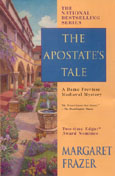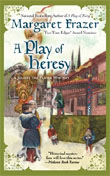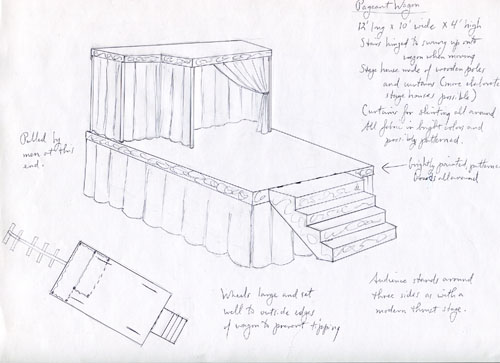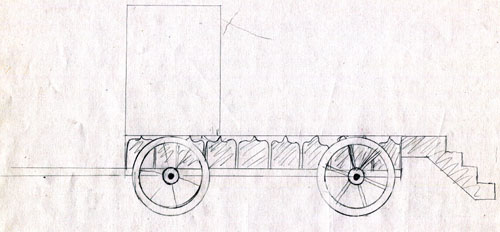
WARNING: This is the original Author’s Note from A Play of Heresy. It contains light SPOILERS for the book. You may want to finish reading the novel before reading this note.
I was already at work on this book when I went to the symposium “Drama and Religion 1555-1575: The Chester Cycle in Context” at the University of Toronto in May 2010. Besides the scholarly papers that were given, the entire cycle of twenty-three medieval plays from Chester, England, were performed out of doors on wagons moved from site to site on the campus over three half-days. The plays began with the Creation of the World and followed through Old and New Testaments to Judgment Day. Each was done by a different group from schools in Canada and the United States, with no attempt to unify their styles; all was done according to the individual group’s own imagination and resources, their styles widely diverging.
As someone who has seen much theater, both from the audience side and while performing on stages, I was as fascinated by the onlookers’ delight as much as by the productions themselves. And by “onlookers’ delight” I mean my own as well as what I saw and heard around me. People watched in riveted delight as the Temptress in the Garden of Eden changed into a slithering serpent; cheered when Moses pulled the tablets of the law from the rocky cliff behind him; laughed ourselves silly at the southern hillbilly shepherds settling down for a night of watching their sheep with their coolers of beer and snacks beside them – and were nonetheless deeply moved by their so-humble but sincere gifts to the Christ child. Nor is anyone likely to forget Herod on his high throne, sneeringly throwing the occasional grape at the audience – or the silence as we watched the Crucifixion. And I’m here to tell you that when the demons burst from the Hellmouth, to prowl and snarl only a few yards from our faces, we were truly taken momentarily aback. Some plays were stronger productions than others, but at the end the overall feeling left was that we had gone on a wonderful journey. You did not have to be Christian in that audience to be carried along on the mythic strength of the story.
In short — brought alive by theatrical imagination, these medieval plays work.
Which pleased me no end, since that was what I was imagining and trying to do with the plays in A Play of Heresy. Unfortunately, unlike the cycle of plays played in Chester and York, only two of the cycle done in Coventry remain – that of the Shearmen & Taylors and that of the Weavers. If you should happen on a book titled Ludus Coventriae or the Plaie Called Corpus Christi, full of plays, take note this was published under the misconception that what are now called the N-Town plays were the lost ones of Coventry. Instead, the book I used the most while writing this story was The Corpus Christi Plays, edited by Pamela M. King and Clifford Davidson, from Medieval Institute Publications, Western Michigan University. Where occasionally things diverge in my story from the facts given in the book, pray remember that nothing is static and what is recorded of plays and pageant houses in the 1500s is not necessarily exactly how things were in the 1400s, a time for which we have less documentation about the plays.
What is intriguing, besides the surviving plays themselves, are the odd bits of information scattered through the town records, such as where some of the guilds had their pageant houses, and the cost for painting Herod’s face and mending the devil’s garment. These are winnowed out and gathered together in the delight-filled Records of Early English Drama: Coventry.
A more immediately available experience of drama in medieval Coventry is that staple of Christmas carols – “The Coventry Carol”. It’s the lullaby that the mothers of Bethlehem sing to their doomed children at the Massacre of the Innocents in the play that, in this book, Basset is directing – one of the two plays that somehow survived when most of the Coventry plays vanished. Listening to the song’s delicate, sorrowing beauty makes one wonder how much of all too perishable grace and beauty is lost from medieval times.
Now for Coventry itself. Again I feel obliged to ask readers to move with me past the clichés about medieval towns, lest it be thought I write too rosy a picture of them. Much of what we “know” about them (such as all their streets were narrow and dark and deep in filth, with people throwing rude things out of upper windows) dates from later centuries, when the shifting economics led to the over-population of towns and cities and the accompanying breakdown of their governmental and social structures. Citizens of medieval towns — quarrelsome and ambitious among themselves though they might be (and the records show they definitely could be) — tended to be very proud and protective of their towns. Sponsoring fine civic events such as the Corpus Christi plays was one way of showing it, mixing piety and civic promotion in a combination very common throughout medieval England. The Tudor economics and their Reformation tore much of that to shreds. For an in-depth look at the inner workings of medieval Coventry, there is The Coventry Leet Book, published by the Early English Text Society.
A number of records exist from medieval Coventry. Out of them, I have amused myself by using names of some actual citizens in this story. There was an actual John Burbage listed in the Coventry subsidy of 1434, when John Burbage of Bayly-lane paid 1s.8d, sign of a prosperous man. Whether he was in any way an ancestor of Shakespeare’s Richard Burbage, I don’t know, but it’s diverting to know that Stratford-upon-Avon is not far from Coventry and that scholars love to speculate that the young Shakespeare may have seen the last performance of these plays in Coventry before the Protestants shut them altogether down. (Turns out it was not, in the long run, the Lollards whom folk had to worry about.) So, if we are speculating, let us speculate that the young Shakespeare perhaps met the young Burbage, descendant of John Burbage, then. (But, no, I am not going to write that story.)
Johanna Byfeld of Much Park Street is likewise in the records. And in the town records for 1441 is the order that “Richard Eme and all others, who play in the Corpus Christi pageant, shall play well and sufficiently, so that no impediment may arise in any play, on pain of 20s. to the town wall.”
Less happily, the 1431 Lollard uprising and its aftermath are also real, as are the executions, among others, of a Thomas Kydwa and of Alice Garton, just as told here. For this background, “Lollardy in Coventry and the Revolt of 1431” by Maureen Jurkowski in The Fifteenth Century, vol. 6: Identity and Insurgency in the Late Middle Ages, edited by Linda Clark, was invaluable.
Of course, should you go looking for medieval places in Coventry mentioned and used in this story, you will find little. The German bombing of 1940 burned out what was left of the medieval heart of the city, including St. Michael’s church (become, by then, St. Michael’s Cathedral) whose shell remains next to the new and glorious cathedral put up in its place for reminder of the great cruelties of mankind and of the grace of forgiveness and mercy.
For a wonderful site for “seeing” Coventry as it was and is, go to http://www.historiccoventry.co.uk. There are maps of Coventry at different times over the centuries, and photographs from the late 1800s into the 21st century. A journey in time both delightful and sad.
For a clearer understanding of how suicide – a word not used until centuries later – was seen and responded to in medieval times, Alexander Murray’s three-volume Suicide in the Middle Ages was invaluable.
Biblical quotations are from the Bible in English – now known as the Wycliffe Bible — available in England in the 1400s. Bibles in English were not completely forbidden. Copies are known to have been owned by several kings, and license from a bishop could be had for lesser people to own one. The Church’s principal objection to the Bible being in English was the abuse some people made of it, taking from it what they wanted in order to justify what they wanted to do. It has always sounded better (at least to the perpetrator) to say, “The Bible made me do it.”
By the by, yes, there were organs in medieval England at the time, including portative ones. Yet again I feel obliged to insist that, despite the tedious media clichés, medieval times should not be summed up as nothing but ignorant, ugly, and brutal, existing under a perpetually overcast sky with plague and warfare every day from the fall of Rome to the Renaissance. The surviving art and literature and music from the time show a love of complexity, order, and beauty. Study of the legal structure and the bureaucracy that supported it evidence a society striving to create and maintain an ordered life. There were of course ugliness and injustices and outbreaks of violence – but those are not exclusive to medieval times and it is grossly unfair to characterize the period as if they were. Almost needless to say, the simplistic willfulness of those who continue to portray the time as “nothing but nasty”, ignoring everything to the good that the medieval world has to offer, annoys the hell out of me.
Not to mention those who can’t trouble themselves to figure out that how things were in 1250 are not likely to match how things were in 1450. Think: 1750 versus 1950. Change happens – in clothing, attitudes, and societal structure. “Even” in the medieval world.
More cheerfully, for those who also read the Dame Frevisse series and happen to remember a rat-faced spy Joliffe encounters when finding excuse to befriend Arteys in The Bastard’s Tale, you may find that scene plays differently now that you have met Sebastian in A Play of Heresy.
– Margaret




















